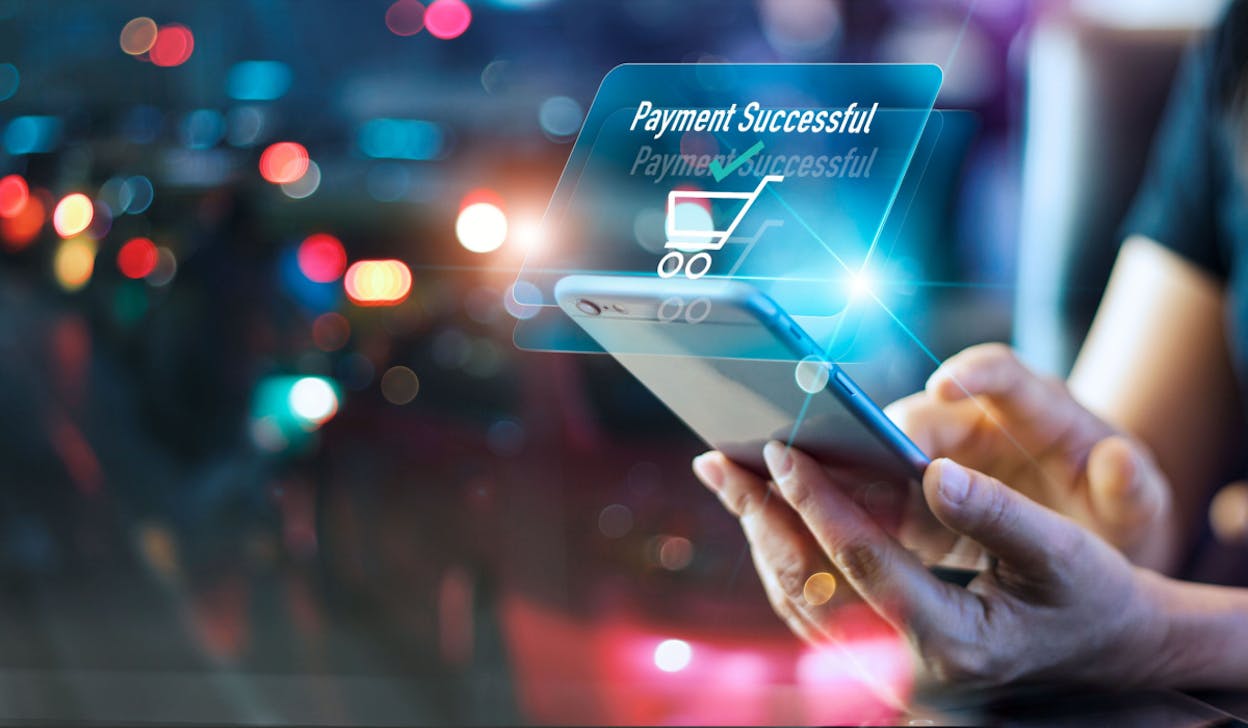What are Instant Payments? (+ How They’re Changing the Industry)

As a retailer or e-commerce store owner, you're constantly looking for ways to enhance customer satisfaction and streamline your operations. Instant payments are not just a trend; they are rapidly becoming a necessity. Gone are the days when customers patiently waited for transaction approvals or businesses reconciled accounts over extended periods. From speeding up transactions to improving cash flow, real-time payments come with a range of benefits for your company and its customers.
But how exactly does this technology work? What impact does it have on your business model? And more importantly, how can you seamlessly integrate it into your existing systems? Read on for answers to these questions and more.
Table of contents
- What are instant payments?
- How does an instant payment work?
- The industry before instant payments
- Benefits of instant payments
- Industries impacted by instant payments
- Technological innovations driving instant payments
- Challenges and concerns
- The future of instant payments
- Adapt to the transformative power of instant payments
What are instant payments?
Instant payments, which are sometimes called immediate payments, real-time payments, or faster payments, are credit transfers that reach your account within ten seconds of processing a payment. This happens in real time, at any time of the day, and on any day of the year, which means funds are immediately available to receivers. Regular online bank transfers usually take at least one working day to reach the recipient’s bank account.
Real-time payments are processed without intermediaries like a clearing house or correspondent banks, which means transfers happen quickly and securely. Instant payments are available in Spain and in any country that is part of the Single Euro Payments Area (SEPA), which includes every EU member state and other countries in the European Economic Area, like the UK and Switzerland.
How does an instant payment work?
Banks and payment providers offer variations in relation to price, the length of the process, and service quality but they are all part of the European Central Bank’s SEPA Credit Transfer (SCT) Standard. As long as both banks involved in a payment or transfer are participants, you can send and receive money in real time. The maximum amount depends on the provider but it ranges between €2,000 and €100,000.
Let’s use Isabel as an example. She wants to buy a new laptop from Lorenzo’s Laptops for €1,500, so she initiates a payment on her mobile banking app. The bank checks if Isabel has enough funds to cover the transaction. If she does, they authorize the payment and push the information across to Lorenzo’s bank, using a faster payments system. Lorenzo’s bank receives and validates the payment by sending a message to Isabel’s bank through the immediate payments system. Once the payment is complete, Isabel receives confirmation and Lorenzo can instantly use the funds in his account to pay a supplier.
The industry before instant payments
It could be said that cash was the first instant payment. Even as far back as 3000 BCE, Barley was used as token money, so you would receive cash from your customers and provide them with a product or service in return. It took millennia for change. From the introduction of coins in 700 BCE to banknotes to checks in the 17th century, the evolution of payments was slow.
Modern technology dramatically sped the process up with the first credit card in 1979, followed by the internet and the possibility to pay without cash or check later in the 20th century. Digital payments are at the heart of everything in the 21st century, including mobile payments, QR code payments, e-wallets, cryptocurrencies, bank transfers, and now instant payments. They have all added layers of speed, convenience, and security to a market where some people, albeit far fewer than before, like to pay with cash.
Benefits of instant payments
There are many benefits for both businesses and consumers, on top of the obvious advantage of speed. Let’s review them:
Speed and efficiency
The most obvious benefit is speed and efficiency. You receive a payment within 10 seconds of a transaction, which means you can use your new funds immediately.
Reduced transaction fees
Some of the costs associated with traditional payments, like check processing fees, are completely or partially removed. Therefore, the total transaction fees are also reduced.
Enhanced security features
On top of all of the normal security features you get with traditional payments, there are new verification provisions in place to make sure a customer is truly paying who they think they are.
Improved cash flow for businesses
Receiving payment in real time has a positive impact on cash flow. Instead of having to wait for payments to come to pay suppliers, staff, etc., you’ll know exactly how much money you have in the moment.
Increased convenience for consumers
If a consumer owes money and needs to pay within a certain time frame to avoid a late fee, they can complete a transaction at the last minute without worry.
Industries impacted by instant payments
Although every industry is in some way impacted, there are some specific sectors where the influence is greater:
Retail and e-commerce
In the retail and e-commerce sectors, more and more businesses are accepting alternative payment methods. Immediate payments are expected by many consumers who want convenience and speed.
🚀 Boost customer satisfaction and sales by accepting more payment methods. Join MONEI with no commitment to test integrations and payments.
Financial services
Moving money to the right place at the right time is vital for any financial service. Previously, it was sometimes necessary to pay early to make sure the recipient gets their funds in time and late payments could cause problems further down the line. Real-time payments have helped financial services to better manage their accounts.
Freelancing and gig economy
For freelancers and workers in the gig economy, faster payments create the space to charge wherever they are and to make sure a payment has been completed. This offers a greater sense of security and a better cash flow to pay suppliers.
Supply chain and logistics
The impact on the supply chain and logistics sector is huge. At every layer of the supply chain, the speed of payments is crucial to making sure the next supplier is paid on time. Once you receive a payment, you can instantly pay a supplier and they can release a product at the same time as paying their suppliers.
Public services
Many public services offer instant payment solutions to the parts of the population that need the money to pay bills. For example, a tax refund or a social security payment could create the space for someone to put a deposit on a house or simply to buy a week’s worth of shopping.
Technological innovations driving instant payments
Instant payments are only possible because of the technological innovations that power them. Here are some of the most important drivers:
Mobile apps and digital wallets.
There are many payment methods available for consumers, largely driven by mobile apps and digital wallets, including Bizum, Apple Pay, Google Pay, SEPA Direct Debit, SEPA Request-to-Pay (SRTP), and MB WAY. With each of these options, consumers are able to make an instant payment.
QR code payments.
QR code payments (something available via MONEI Pay) allow consumers to scan a digital QR code to complete contactless transactions in real time.
Near field communication (NFC) technology.
Without NFC technology, mobile payments wouldn’t exist. It’s the technology that allows you to accept payments from mobile apps and digital wallets, contactless credit cards, and even smartwatches.
Blockchain and cryptocurrencies.
Blockchain and cryptocurrencies are a type of instant payment as you can transfer money directly into a recipient's account in real time. It’s still a relatively new technology but as more people and businesses start to use it, it’s becoming a trusted way to finalize a transaction.
Challenges and concerns
Although immediate payments are having a positive impact, there are some challenges and concerns to consider and overcome:
Potential for fraud and security breaches
As transactions are made so quickly, it’s not possible to recall a payment if something goes wrong, leaving open the possibility for fraud and security breaches. With the right PSP, you get built-in security like PSD2, 3D Secure checkouts, and strong customer authentication (SCA), meaning you’ll always have secure payments.
Integrations between different payment platforms
There are so many payment methods available that it can be hard to integrate with multiple payment platforms and to keep a consistent experience for your customers. Fortunately, with MONEI, you have one platform that integrates with your business to accept a range of payment methods, including instant payment methods like QR codes, bank transfers, digital wallets, and more.
Regulatory and compliance issues
There are a lot of regulatory and compliance challenges to keep up with and that can take time and resources, unless you use a PCI compliant PSP like MONEI, that mitigates this issue.
Adapting to rapidly changing technology
There always seems to be something new to think about with payments and real-time payments are no exception. Keeping up with everything so you can look after your customers properly can seem daunting. That is unless you don’t have to. With a payments platform like MONEI that’s constantly innovating, it’s all handled for you.
The future of instant payments
In the next five to 10 years, we can expect instant payments to become the norm rather than the exception. It’s already possible in many markets, so as more consumers demand faster transaction times, you’ll need to keep adapting. To prepare, start by updating your payment system and ensuring it’s compatible with the latest digital payment methods.
Instant payments won't exist in isolation. They'll likely merge with other cutting-edge technologies like Artificial Intelligence (AI) and the Internet of Things (IoT). Imagine your smart fridge ordering and paying for groceries the moment you run out, or AI-driven chatbots making instant refunds for online shoppers. As these technologies become more integrated, the possibilities for instant payments will expand, offering more convenience and efficiency for both businesses and consumers.
Adapt to the transformative power of instant payments
If someone had mentioned just a decade ago that it would be possible to make a payment within ten seconds or less, you might have laughed at them but as you have read, it’s not only possible today, it’s becoming the norm. That’s why it’s crucial to embrace and adopt the change with the right PSP.
Instant payments FAQ
What are SEPA instant payments?
SEPA instant payments (also known as SEPA Instant Credit Transfers) transfer money from a payee to a recipient within 10 seconds. SEPA is the Single Euro Payments Area and includes all members of the EU, as well as nine countries that are not part of the EU, including the UK.
What is an instant transfer?
An instant transfer is also known as an instant payment, an immediate payment, a real-time payment or a faster payment. Although there are different names, the meaning is the same. A transfer is made instantly from a payee to a recipient.
How long does it take for an immediate transfer to arrive?
The ECB (European Central Bank) says that an immediate transfer takes less than 10 seconds to arrive.

Alexis Damen
Alexis Damen is a former Shopify merchant turned content marketer. Here, she breaks down complex topics about payments, e-commerce, and retail to help you succeed (with MONEI as your payments partner, of course).

